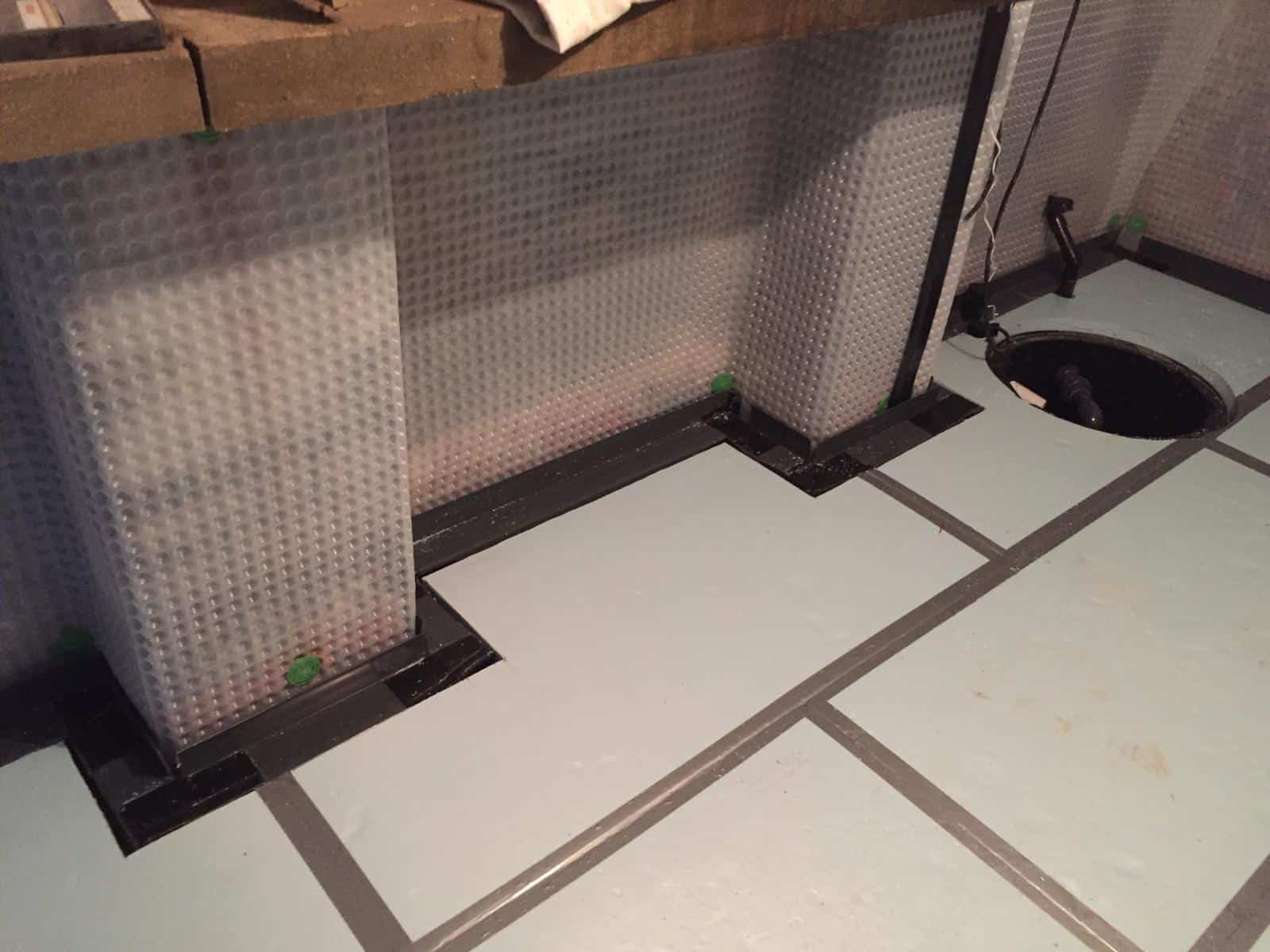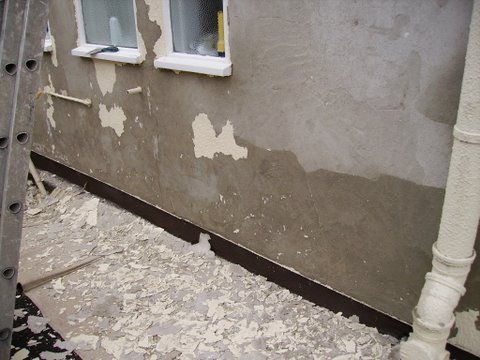Recognizing the Relevance of Damp Proofing in Preventing Structural Damage
Wet proofing offers as an essential protection versus dampness infiltration in buildings. This protective action can prevent considerable structural damages, yet lots of homeowner remain unaware of its relevance. Identifying the indications of dampness and comprehending the various solutions offered can be critical. Disregarding damp proofing can lead to serious consequences. What are the details dangers and solutions that homeowner should consider?
What Perspires Proofing and Just How Does It Function?
Moist proofing functions as a crucial obstacle versus wetness breach in buildings. damp removal newcastle. This process includes using specific materials and methods to stop water from permeating walls, floors, and other architectural elements. Generally, damp proofing can be accomplished with the setup of moist evidence membranes, coverings, or making use of specialized sealants.These methods function by developing a safety layer that hinders wetness activity, guaranteeing that the indoor environment remains dry and healthy and balanced. Moist proofing is specifically essential in locations vulnerable to high moisture or groundwater, as it aids preserve the integrity of the structure over time.Moreover, reliable wet proofing adds to power effectiveness by preventing heat loss associated with moist settings. By addressing potential dampness concerns before they intensify, damp proofing serves as a proactive procedure in guarding structures from the damaging results of water damages, eventually prolonging their lifespan and maintaining their worth
Common Indicators of Wetness in a Structure
Dampness problems within a building can manifest via numerous recognizable indications that suggest the presence of wetness. One prominent sign is the appearance of water discolorations on walls or ceilings, which often indicates dampness infiltration. Furthermore, peeling or gurgling paint can recommend that excess humidity is entraped below the surface, leading to damage. One more common indicator is the visibility of mold and mildew and mildew, which thrive in wet conditions and can usually be determined by their stuffy odor. In addition, a surge in humidity levels can create condensation on windows and other surfaces, highlighting moisture issues. Uneven or deformed floor covering may indicate underlying wetness that compromises architectural honesty. Acknowledging these signs early can aid reduce potential damage and preserve a risk-free living atmosphere. Regular inspections and timely action are important in attending to wetness problems prior to they escalate.
The Risks of Ignoring Damp Proofing
Disregarding damp proofing can lead to substantial threats to a structure's architectural stability, as dampness accumulation may weaken foundations and wall surfaces. In addition, prolonged dampness creates an atmosphere for mold development, presenting serious carcinogen to owners. Resolving these dangers is essential for making certain both safety and long life of the building.
Architectural Honesty Dangers
When property owners ignore the value of efficient damp proofing, they expose their homes to considerable architectural stability risks. Prolonged wetness infiltration can cause the advancement of mold and mildew, which deteriorates fundamental components and can endanger total security. Additionally, excess dampness can wear down concrete and brickwork, resulting in cracks and structural failures. Wood elements are specifically prone; they can rot and lose load-bearing capacity, posturing serious dangers to the building's framework. Untreated damp problems may attract parasites, such as termites, which further worsen architectural deterioration. Eventually, overlooking wet proofing procedures can bring about expensive fixings and potential security risks, highlighting the essential role of proactive damp monitoring in maintaining the honesty of residential homes.
Carcinogen Issues
How can an apparently small oversight cause significant wellness threats? Disregarding moist proofing can develop a setting helpful to mold and mildew growth, which presents considerable health and wellness dangers. Mold and mildew spores can trigger sensitive responses, respiratory problems, and other health and wellness problems, particularly in at risk populaces such as children, the senior, and individuals with pre-existing problems. Furthermore, persistent wetness can attract bugs like rodents and pests, which bring conditions that further compromise health. The presence of wetness additionally adds to a decline in indoor air high quality, aggravating bronchial asthma and various other respiratory disorders. Consequently, the failing to deal with wet concerns not only endangers architectural integrity however also threatens the well-being of residents, highlighting the crucial demand for effective wet proofing measures.
Different Kinds Of Damp Proofing Solutions
Although various variables can add to damp problems in structures, choosing the proper wet proofing service is essential for protecting architectural stability. A number of alternatives are readily available, each customized to particular conditions.One usual remedy is a damp-proof membrane (DPM), generally made from polyethylene or bitumen, which is set up in floorings and walls to stop dampness access. Another option is damp-proof courses (DPC), which are layers of waterproof product placed within walls to block increasing damp.Chemical damp proofing includes injecting waterproofing chemicals into walls to develop an obstacle versus moisture. Furthermore, outside treatments such as tanking, which involves applying a waterproof layer to the exterior of foundations, can be efficient in stopping water penetration.Each option has its advantages and is selected based upon the structure's certain issues, environmental conditions, and long-lasting maintenance factors to consider, guaranteeing suitable protection against damp-related damage.

The Cost of Damp Damages vs. Prevention
Recognizing the monetary effects of moist damages contrasted to avoidance highlights the significance of positive steps. The expenses related to wet damages can be considerable, including repair work to architectural elements, mold and mildew removal, and possible health-related expenditures. Home owners might encounter considerable monetary stress if substantial damage occurs, causing enhanced insurance premiums and lost home value.In contrast, purchasing wet proofing remedies is normally even more economical. Initial expenses for avoidance approaches, such as improving or setting up damp-proof membrane layers water drainage systems, are often surpassed by the long-lasting cost savings from staying clear of expensive repairs. Additionally, preventing damp problems can enhance a home's total value and appeal, making it a smart financial investment. When examining the price of moist damages versus avoidance, it comes to be clear that taking aggressive steps can guard economic interests and preserve the stability of the residential or commercial property with time.
Selecting the Right Damp Proofing Method for Your Building
Which moist proofing method is most suitable for a details residential or commercial property usually depends upon various elements, including the structure's age, existing moisture problems, and neighborhood ecological conditions. For older frameworks, standard methods such as asphalt membranes or cementitious coatings might be more efficient, as they can give a robust barrier against increasing moist. On the other hand, more recent buildings may gain from contemporary services like infused damp-proof programs, which are less invasive and can be tailored to particular dampness challenges.Additionally, residential or commercial properties in locations with high water tables or hefty rains might require even more advanced techniques, such as tooth cavity wall surface drain systems or exterior waterproofing. Homeowners must also take into consideration the specific materials used in their building's building and construction, as some techniques may not work. Inevitably, a complete evaluation by an expert can guide homeowner in choosing the most effective damp proofing method tailored to their one-of-a-kind circumstances.
Maintaining Your Damp Proofing System With Time
Normal upkeep of a wet proofing system is crucial for guaranteeing its long-lasting performance and shielding a property from moisture-related damage. Residential property owners should conduct routine examinations to determine any signs of wear or concession in the moist website proofing layer. This includes monitoring for splits, peeling off paint, or mold growth, which may indicate dampness intrusion.Additionally, it is suggested to clean seamless gutters and downspouts consistently to stop water buildup around the structure. If damage is observed.Engaging expert services for periodic assessments can further improve the durability of the system, reapplying membranes or sealants may be necessary. These experts can supply understandings right into potential susceptabilities and advise timely repairs.
Frequently Asked Questions
How Much Time Does Damp Proofing Therapy Last Prior To Requiring Repairs?
The longevity of damp proofing treatment commonly ranges from 10 to 30 years, depending upon variables such as the approach utilized, environmental conditions, and maintenance techniques. Regular inspections can aid determine when repairs may be necessary.
Is Do It Yourself Damp Proofing Effective Compared to Expert Providers?
The efficiency of DIY moist proofing varies substantially. mould treatment newcastle. While some people may achieve sufficient outcomes, expert solutions typically ensure thorough options, leveraging expertise and high quality materials to avoid future problems extra reliably than most do it yourself efforts
Can Damp Proofing Improve Indoor Air Top Quality?
The concern of whether moist proofing can improve indoor air top quality emerges regularly. Efficient damp proofing reduces wetness levels, therefore minimizing mold development and irritants, eventually adding to a healthier indoor setting for passengers.
Exist Specific Rules for Damp Proofing in Different Areas?
Laws for moist proofing differ by region, usually influenced by regional building ordinance and ecological conditions. Compliance warranties effective moisture control, protecting structures and advertising safety, which highlights the need for adherence to these particular guidelines.

What Are the Long-Term Perks of Proper Damp Proofing?
The long-term advantages of proper damp proofing include boosted structural stability, decreased upkeep costs, boosted interior air quality, and boosted building worth. These advantages add to a much healthier living atmosphere and prolonged life expectancy of buildings. Generally, damp proofing can be accomplished through the installment of wet evidence membrane layers, finishings, or the use of specialized sealants.These approaches function by producing a protective layer that inhibits wetness motion, guaranteeing that the interior environment continues to be dry and healthy and balanced. Wet proofing is especially crucial in areas prone to high moisture or groundwater, as it helps maintain the stability of the framework over time.Moreover, reliable wet proofing contributes to power performance by stopping warm loss associated with damp settings. Disregarding wet proofing can lead to considerable dangers to a building's architectural honesty, as wetness buildup might weaken wall surfaces and foundations (damp proofing newcastle). Various elements can add to damp problems in structures, selecting the appropriate wet proofing service is vital for preserving architectural honesty. Which wet proofing approach is most appropriate for a specific residential property typically depends on various aspects, consisting of the building's age, existing dampness issues, and regional environmental problems